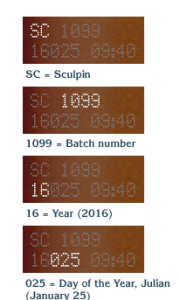 Beer-drinking usually leads to talking about beer and I’m ever-surprised by what people know, don’t know, think they know or just kinda fabricate (aka, “that’s the beer talking”). (And there’s always more to know, as ace beer writer Jason Notte tweeted last week, “The more I cover the #beer industry, the more clear it is how little I know about it.”). One topic that often pops up during a round of beer-drinking-and-talking is getting burned by buying brews that are malingering on shelves looooong past their freshness window (and even the best beer stores have old stock hanging around). So here’s an intro to how to break those vexing beer codes.
Beer-drinking usually leads to talking about beer and I’m ever-surprised by what people know, don’t know, think they know or just kinda fabricate (aka, “that’s the beer talking”). (And there’s always more to know, as ace beer writer Jason Notte tweeted last week, “The more I cover the #beer industry, the more clear it is how little I know about it.”). One topic that often pops up during a round of beer-drinking-and-talking is getting burned by buying brews that are malingering on shelves looooong past their freshness window (and even the best beer stores have old stock hanging around). So here’s an intro to how to break those vexing beer codes.
Knowing when the beer was made is vital knowledge, particularly for those mega-popular, mega-hopped IPAs; the aromas, flavor and bitterness drop off quickly. Unfortunately, many brewers still don’t make it easy to figure out when their beer was bottled or canned. There is a morass of confounding letter/number combos: Julian dates, best before dates (but when were they packaged?!), codes that don’t specify whether it’s a born-on or pull-by date, etc. Some codes are printed on the glass and are easily smudged; others are on the label but are near-impossible to read, overlapping with the imagery and label copy. Even worse: Some codes are only stamped on the case, not the individual containers. Most consumers have no idea what those letters and numbers mean.
Want to decode the “2JT” on Anchor Brewing’s bottles and cans? Um, it’s “easy”! Quoth their website: “The first character is always numeric and represents the last digit of the year. The second character is always alpha and represents the month by using the first letter of the month unless that letter has already been used.” Months are coded thusly: J = Jan, F = Feb, M = Mar, A = Apr, Y = May, U = Jun, L = Jul, G = Aug, S = Sep, O = Oct, N = Nov, D = Dec. “The third character in the code is either alpha or numeric and tells the day of the month. The first 26 days are represented by the alphabet with the remaining days listed as: 27th through 29th = 7 through 9; 30th= 3; 31st= 1. An example of a date code would be January 20, 2012 = 2JT.” See? Easy! (Check out the image on this page for Ballast Point’s code breakdown.)
But there’s a handy one-stop to crack most of the brewers’ codes: Fresh Beer Only (sites.google.com/site/freshbeeronly/u-s-beer-list). Looking at Lagunitas? “Uses a bottling date. Julian date code, which is written in black on the neck of the bottle. There are two lines. First line has 3 digits followed by a space, then one more digit. The first three digits represent the day of the year, last digit is the last number of the year. Ex: 135 3 would be the 135th day of 2013 (May 15). Second line is batch number and military time.” And you’ll need to know that Magic Hat skips a letter: “Uses a production date. Ex.: M051. M= December (A=January, B=Feb, etc. I is skipped, so J=September, etc.), 05= 5th day, 1= 2011. Recommended shelf life 120 days from that date.” Ouch, my head hurts! But Fresh Beer Only can help ease the pain.
Pro tip: There’s a sure-fire way to get brand-new beer – buy local! Visit our beermakers to enjoy the freshest fermented beverages in 401 Land! No codes required!
For more beer news, check Lou’s blog, bottlescansclaphands.wordpress.com, or follow @BottlesCansRI.

